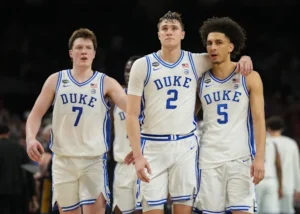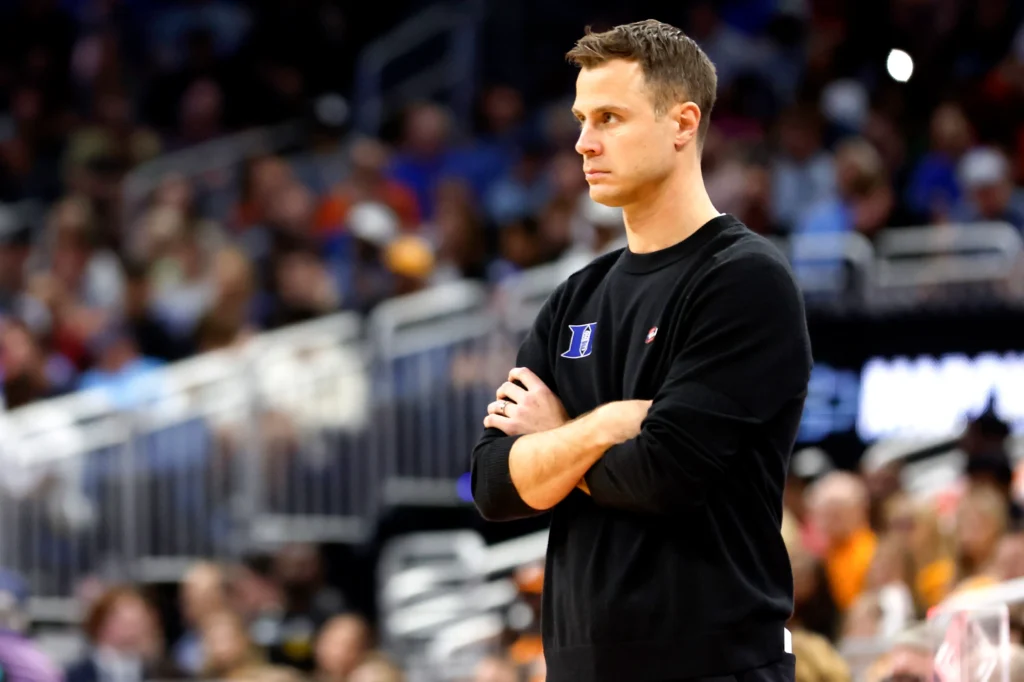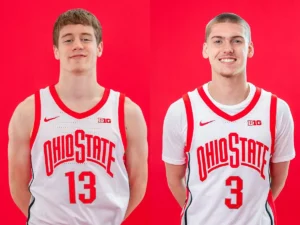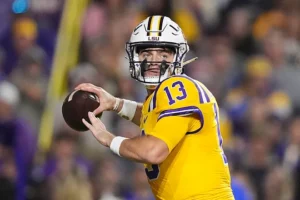
The 2025 NBA Draft, held over two days at Brooklyn’s Barclays Center, brought a wave of fresh talent and unforgettable moments. With 58 players selected, the draft served as a turning point for several franchises, many of whom sought to redefine their futures through calculated risks and foundational picks. The selections reflected a mix of generational talent, under-the-radar gems, international reach, and evolving philosophies about the modern NBA athlete.
This year’s draft lottery set the stage for drama early. The Dallas Mavericks, despite entering with just a 1.8% chance to land the top pick, shocked the basketball world by securing the No. 1 overall selection. It marked a seismic moment for the franchise, especially following major roster changes that included parting ways with longtime star Luka Dončić and acquiring veteran forward Anthony Davis. With their newfound cornerstone opportunity, Dallas selected Duke phenom Cooper Flagg—a prospect widely viewed as the most complete player in the class.
Flagg, a 6-foot-9 forward with an elite blend of versatility, defense, and offensive polish, delivered an outstanding freshman season at Duke. Averaging 19.2 points, 7.5 rebounds, 4.2 assists, and a combination of steals and blocks that rivaled seasoned pros, Flagg dazzled scouts throughout the year. His defensive instincts and basketball IQ have drawn comparisons to some of the NBA’s most intelligent two-way forwards. In Flagg, Dallas sees a long-term franchise player, capable of anchoring both ends of the court and evolving into a multi-time All-Star.
At No. 2, the San Antonio Spurs made a strategic selection in guard Dylan Harper out of Rutgers. Harper, a dynamic and strong-bodied point guard, brings a tough, physical play style and exceptional vision. He is considered a perfect complement to Victor Wembanyama, giving San Antonio a backcourt floor general who can handle pressure, create for others, and score when necessary. His outside shooting remains a development area, but his leadership qualities and feel for the game made him an attractive pick.
The Philadelphia 76ers added high-scoring Baylor guard V.J. Edgecombe with the third pick. A well-rounded shooting guard with a powerful first step, Edgecombe excels at creating separation and defending opposing wings. Philadelphia has been seeking depth on the perimeter, and Edgecombe fits their style: active, athletic, and able to contribute on both ends. His college efficiency and physical maturity suggest he can make an immediate impact.
Charlotte continued its youth movement by selecting Kon Knueppel at No. 4. The North Carolina-born shooting guard made headlines with his lights-out perimeter shooting during the NCAA season, finishing with a 40%+ clip from beyond the arc and a free-throw percentage above 90%. He brings spacing and intelligence, essential for a team building around LaMelo Ball and Brandon Miller. His game has drawn comparisons to classic sharpshooters with size and a knack for moving off screens.
At No. 5, the Utah Jazz took a bold swing with Rutgers forward Ace Bailey. At 6-foot-10 with guard-like skills, Bailey is one of the draft’s most athletic and intriguing prospects. His decision to skip some pre-draft workouts caused him to slide a bit from earlier projections, and public criticism followed. But the Jazz saw the potential for stardom. Bailey’s vertical explosion, defensive length, and offensive versatility give Utah a high-risk, high-reward player that could become a matchup nightmare if developed properly.
The Washington Wizards made a sound selection at No. 6 by taking Tre Johnson, a scoring guard known for his smooth shooting and shot creation. He has shown flashes of Devin Booker-style scoring and could be a foundational piece for a Wizards team desperate for perimeter firepower.
At No. 7, the New Orleans Pelicans picked Jeremiah Fears, a gritty, two-way point guard with a high motor and excellent decision-making. His defensive effort and consistency at Michigan State made him one of the most NBA-ready guards in the class.
Brooklyn was perhaps the most active team in the draft, entering the night with five first-round picks. At No. 8, they chose Egor Demin, a 6-foot-9 playmaker from France who projects as a tall point guard in the mold of modern initiators like Josh Giddey or Franz Wagner. Demin’s feel for the game, passing ability, and size make him a fascinating project for a team looking to rebuild through development.
Toronto made a somewhat surprising pick at No. 9, selecting South Carolina forward Collin Murray-Boyles. Known for his rebounding tenacity and inside scoring touch, Murray-Boyles provides frontcourt depth and toughness. He isn’t flashy, but his motor and physicality make him a reliable contributor.
The Phoenix Suns, via Houston’s pick, closed the top ten by selecting Duke center Khaman Maluach. The South Sudanese big man’s journey—from growing up in a refugee camp to being a top-ten pick—was one of the most emotional stories of the night. Maluach brings shot-blocking, rebounding, and developing range. He joins a Suns team in need of depth behind their aging core and could develop into a premier rim protector.
Throughout the remainder of the first round, several intriguing picks stood out. The 76ers added Cedric Coward at No. 11, a well-rounded wing with a strong frame and defensive upside. Chicago brought in German forward Noa Essengue at No. 12, another versatile prospect with stretch-four potential. Atlanta drafted Maryland’s skilled center Derik Queen at No. 13, while Phoenix used their second pick of the round to select Arizona’s Carter Bryant at No. 14, a high-flying wing with scoring instincts.
Oklahoma City made one of the most discussed selections at No. 15, drafting Georgetown center Thomas Sorber. Though projected as a late first or early second-round pick, Sorber’s elite defensive instincts and rebounding skill earned him an early call-up. Many analysts praised the Thunder for prioritizing fit and defense, especially with a team that already boasts offensive talent in Shai Gilgeous-Alexander and Jalen Williams.
International flavor was again prominent in this draft. Players like Demin, Yang Hansen from China, and Rocco Zikarsky from Australia added to the NBA’s growing global presence. The league’s investment in worldwide scouting and development programs continues to bear fruit, and 2025 was no exception.
One of the themes that emerged was the move away from traditional positional thinking. Several teams drafted hybrid players—big guards, stretch bigs, defensive wings capable of initiating offense. Cooper Flagg, Bailey, and Demin all represent this new mold of “positionless” players who can switch assignments, stretch the floor, and handle the ball.
Draft grades from analysts were largely positive for the top five picks. Flagg received near-universal A+ marks, while Harper and Edgecombe were praised for their immediate impact potential. Bailey’s grade was slightly lower due to pre-draft concerns, but his ceiling was described as “limitless.” Teams that drew praise included Dallas for their bold rebuild, Brooklyn for their volume of strategic picks, and Utah for taking a swing at upside. Charlotte and San Antonio were both seen as aligning their selections with long-term team-building strategies.
Several second-round picks also drew attention. Tyrese Proctor from Duke, a savvy floor general, landed with the Cleveland Cavaliers and is viewed as a potential rotation player from day one. Other sleeper picks included Joakim Malek, a sharpshooting wing from Serbia, and Reggie Moore, an undersized but relentless scorer from Xavier.
Looking ahead, this draft class appears to have strong depth and a handful of potential superstars. Flagg is the obvious headliner, but names like Harper, Bailey, and Edgecombe could shape the next decade of basketball. Much will depend on development, coaching, and team fit. The NBA’s evolving landscape—emphasizing versatility, shooting, and adaptability—favors many of the players taken in 2025.
Dallas has now reset its franchise with a new identity. The departure of Luka Dončić was a painful chapter, but with Davis on board and Flagg as the face of the future, the Mavericks are poised for a new era. The Spurs continue to build methodically around Wembanyama, pairing him with a backcourt leader in Harper. Brooklyn’s multi-pick approach echoes the “asset collection” strategy of teams like Oklahoma City in recent years. Whether it yields stars or trade pieces remains to be seen, but it marks a commitment to a long-term vision.
In all, the 2025 NBA Draft was more than a selection of names. It was a marker of transitions, bold decisions, and renewed hope. Franchises on the brink of contention found building blocks. Rebuilding teams discovered their direction. Young athletes fulfilled lifelong dreams. And for fans, the night served as a reminder that while no pick is guaranteed, every draft is a chance to believe again.
As the next NBA season approaches, eyes will be on the rookies. How will Flagg handle the spotlight? Can Harper and Edgecombe translate their college dominance into pro success? Will Bailey silence the doubters? And will players taken deeper in the draft carve out roles and become surprise contributors? Time will tell, but one thing is clear—the class of 2025 has arrived, and with it, the future of the NBA takes another bold step forward.





